#they inject some cancer cells
Text
fuck aidan jasper all my homies hate aidan jasper
#a rental car takes a left down rake street and disappears#I'm glaring at him in my outline#i think a lot of the stupidity i projected onto reuben march belongs on Jasper instead#march gives the go ahead but jasper has FUN with it all#aidan jasper is the one who does most of the poking prodding torturing cough cough I mean medical experiments on nat#fun fact! nat is conscious for all of it :-)#being operated on..... and other things :-)#the first phase of jasper's research is just ''lets fuck this vampire up and record how he heals''#they take a couple organs out#they inject some cancer cells#they remove some skin#they cut some fingles off#then nat gets tossed back into his sad little steel room to heal and maybe do a murder but hes trying real hard#not to do a murder bc they just threw some random hypnotised human in there with him#anyway.#fuck aidan jasper all my homies hate aidan jasper!!!!#its fine nat gets to tear jasper's heart out of his chest later#angery.....#so yes i will b shifting a lot of Reuben March's views and biases on vampirism onto jasper#dw march is definitely still gonna die tho#quinn will hunt him down dont u worry :-)#oh also fun fact this is the bit in the story where nat digests his own appendix LMAO#his body is just like. uhhhhh. we have better uses for this. lets melt it down and turn it into something else#like..... bro???
11 notes
·
View notes
Text
So. Now that she's home and safe and gonna be ok, I can talk about this.
I almost lost Kaiju. Christmas Day. I was woken up by a phone call from Allison, who will be referred to a LOT in this story. Allison runs the pet store where I board Kaiju. She called to tell me that Kaiju had lost a LOT of blood. (As it turns out, half her blood volume. Humans die when we lose 40%, just so you know. She lost 50%.)
There were no visible injuries, and she had passed a bloody stool. Or rather, a blood clot with some poop in it. She continued to pass only blood when they put her in the bathtub to clean her up. If I'd taken her anywhere else, that... would have been it, probably.
But Allison is an actual miracle worker and knew an emergency vet who was open- on Christmas Day- and could see reptiles. As soon as she called me, she took her to the e vet, where they gave her fluids and oxygen and got her stable. They did some x rays and found... nothing.
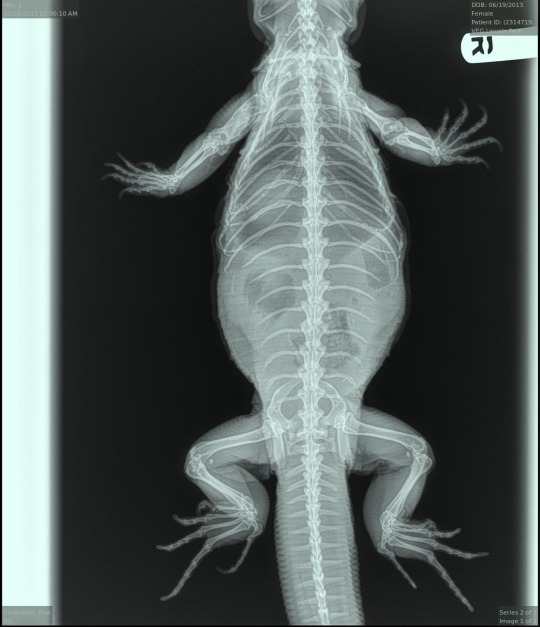

In fact, the e vet actually complimented me on her bone density and how nice her toe joints look. Whatever this mysterious haemorrhage was, it was in the soft tissue.
The immediate thoughts were:
Impaction
Cancer invading an artery
Aneurism
Reproductive issues
However, the emergency vet couldn't figure it out, and my vet was out of the country. The e vet consulted with a lot of vets and it was decided she'd go into Chicago Exotics for care the next day- they were willing to see her on immediate notice. Allison drove her over and they did an ultrasound... and couldn't differentiate the mass they found.
So, exploratory surgery it was.
But... she didn't have enough blood for that. She wouldn't have survived... if Allison hadn't found blood for her. Tegu donors were found, the transfusion happened, and was completely successful.
And what the surgery found was completely unexpected. No cancer. No repro issues. No typical impaction.
Instead? Weird white things in her muscles and a partial impaction that seems to be related to a reduction in her ability to properly digest. There are two possible diagnoses at this point. One is visceral gout. This is very strange because in reptiles, articular gout basically always happens first, and her kidneys are fine.
The other option? Weird, potentially cross species parasite she picked up when she was in the Everglades. Something she's likely had all her life, something that was dormant until recently.
I'll know when the pathology report comes back in a week or so.
Anyways! She is doing very well. She is alert and interested in things. She has an incredible appetite, even though she can't have solid food yet. She's on three meds, including one I have to inject. At her three week recheck, we will add a fourth- either the correct anti-parasitic or a medication to improve kidney function, depending on the diagnosis. Currently she's in a hospital cage and she hates it- she can't have any substrate because of the stitches.
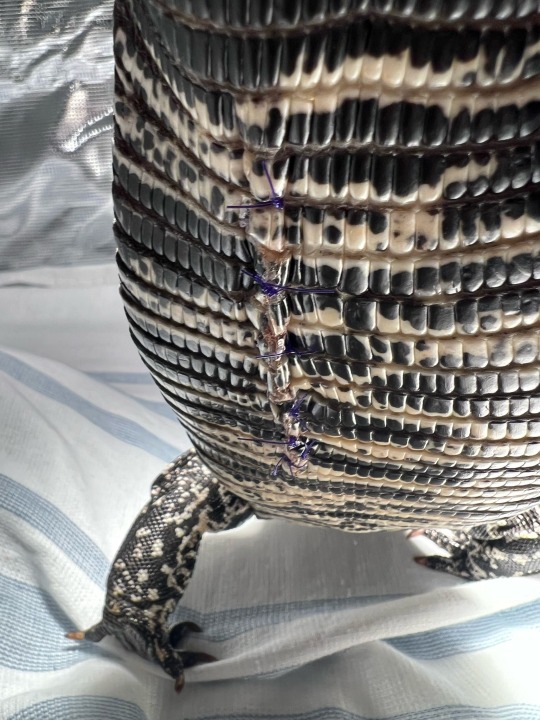
The vet says it should take about three months until she makes her full blood volume. Her pack cell count should be at 35%. It was at 7% on the 26th. But by the 28th, it was at 10%. She's gonna be ok. She's tough. My little girl is a fighter, always has been. You have to be scrappy to survive in the wild.
And throughout this entire experience, everybody has told me how lovely her personality is. Through the injections and cloacal probing and everything, she never bit or even tried to. The vet didn't think she even wanted to bite. Like it wasn't a question of wanting to bite and not being strong enough- it's just not something in her behavioural repertoire. She doesn't bite because she doesn't want to. Because even at her most scared, at her most painful, she's still Kaiju, the best tegu to ever live. Love is stored in the tegu, and it continues to be stored in the tegu. We have a long road ahead of us, but she's out of the woods and is going to be ok. We both are.
Also, consider this a MAJOR plug for Curious Creatures in Chicago. I'm never going to board my animals anywhere else.

1K notes
·
View notes
Text
"In a first-ever human clinical trial, an mRNA cancer vaccine developed at the University of Florida successfully reprogrammed patients’ immune systems to fiercely attack glioblastoma, the most aggressive and lethal brain tumor.
The results in four adult patients mirrored those in 10 pet dog patients suffering from brain tumors whose owners approved of their participation.
The discovery represents a potential new way to recruit the immune system to fight treatment-resistant cancers using an iteration of mRNA technology and lipid nanoparticles, similar to COVID-19 vaccines, but with two key differences: use of a patient’s own tumor cells to create a personalized vaccine, and a newly engineered complex delivery mechanism within the vaccine.
“Instead of us injecting single particles, we’re injecting clusters of particles that are wrapping around each other like onions,” said senior author Elias Sayour, M.D., Ph.D., a UF Health pediatric oncologist who pioneered the new vaccine, which like other immunotherapies attempts to “educate” the immune system that a tumor is foreign.
“These clusters alert the immune system in a much more profound way than single particles would.”
Among the most impressive findings was how quickly the new method spurred a vigorous immune-system response to reject the tumor, said Sayour, principal investigator at the University’s RNA Engineering Laboratory and McKnight Brain Institute investigator who led the multi-institution research team.
“In less than 48 hours, we could see these tumors shifting from what we refer to as ‘cold’—very few immune cells, very silenced immune response—to ‘hot,’ very active immune response,” he said.
“That was very surprising given how quick this happened, and what that told us is we were able to activate the early part of the immune system very rapidly against these cancers, and that’s critical to unlock the later effects of the immune response,” he explained in a video (below).
Glioblastoma is among the most devastating diagnoses, with median survival around 15 months. Current standard of care involves surgery, radiation and some combination of chemotherapy.
The new report, published May 1 in the journal Cell, is the culmination of seven years of promising studies, starting in preclinical mouse models.
In the cohort of four patients, genetic material called RNA was extracted from each patient’s own surgically removed tumor, and then messenger RNA (mRNA)—the blueprint of what is inside every cell, including tumor cells—was amplified and wrapped in the newly designed high-tech packaging of biocompatible lipid nanoparticles, to make tumor cells “look” like a dangerous virus when reinjected into the bloodstream to prompt an immune-system response.
The vaccine was personalized to each patient with a goal of getting the most out of their unique immune system...
While too early in the trial to assess the clinical effects of the vaccine, the patients either lived disease-free longer than expected or survived longer than expected. The 10 pet dogs lived a median of 4.5 months, compared with a median survival of 30-60 days typical for dogs with the condition.
The next step, with support from the Food and Drug Administration and the CureSearch for Children’s Cancer foundation, will be an expanded Phase I clinical trial to include up to 24 adult and pediatric patients to validate the findings. Once an optimal and safe dose is confirmed, an estimated 25 children would participate in Phase 2."
-via Good News Network, May 11, 2024
youtube
-video via University of Florida Health, May 1, 2024
#cw cancer#cw death#cw animal death#medical news and technology#cancer#brain cancer#cancer treatment#tumor#brain tumor#florida#university of florida#medicine#biology#cell biology#mrna#mrna vaccine#vaccines#oncology#good news#hope#Youtube
389 notes
·
View notes
Text
the one thing I have heard probably the most consistently, from the most people, since being diagnosed with breast cancer, is that I have a "good attitude;" meaning, that I make jokes about having cancer, which makes whoever is listening to me feel better about the fact that I have cancer.
Here's the thing - the worst part of having cancer (so far, in my experience - I'll update as this progresses) is having to live with the constant, oppressive dread that right now, somewhere in my body, a cancer cell is taking root in my bones, or in my lungs. That it will silently grow, and spread, and eventually become rampant and untreatable, killing me decades before my time, and I won't know that I'm on that course until it's too late to do anything about it. That I will have to leave my wife alone, that she will have to watch me die painfully and without dignity, and that I will leave this world without having had the time to see so much of what makes it beautiful and strange.
this is not a funny thought!
However, the second worst part of having cancer is - okay, so they removed the tumor, right, and at the same time, they also removed a clump of lymph nodes in my armpit. They do that to test whether or not the cancer has spread. So coming out of surgery, I have two incision sites: one above where the tumor was, and the other one on my trunk right about where your bra passes under your arm.
And that means I'm not allowed to wear deodorant for ten days.
Imagine me: stinky, in my bed. I am an adult woman with a beating heart. I will not claim I have any greater share of dignity or wisdom than a typical example of my cohort, but I have lived and learned and erred, and amassed a small collection of accomplishments which I would not be ashamed to present to God at my reckoning, should such a being exist, and should such a reckoning take place. Times when I have shown meaningful kindness to someone when it would have been more convenient or popular to do nothing. Times when I have told a necessary truth to my own painful detriment. Things I have made that possessed, to at least a meager measure, a glimmer of genuine beauty. Trust I have earned, and not betrayed. I'm not a saint, but my soul is not nothing, and as I am forced to reckon with my own mortality in a way that few people my age ever do, I, like - I smell pretty bad? And like - my armpit is, like, clammy. I mean, how long has it been since you didn't wear deodorant for multiple days. There's a change in texture that I was not expecting. Just in the right armpit! The left armpit is fine, she gets to have deodorant.
But like, stress makes the B.O. situation not so hot, and I'm medically prohibited from doing the one thing that would rectify the situation. I own deodorant. It's right over there. I can see it from where I'm sitting. I am sure you understand of course that I am immersed in greater miseries. Even aside from the existential dread of having cancer - the incisions are painful. I'm very tired. I have two blown-out veins from when the anesthesiologist struggled to find a workable injection site before the surgery, so I have some wild bruising, and I can't really bend my left arm. But these are afflictions with some dignity. To have pain or fatigue after surgery is rather ennobled in the common discourse. But - do I have to smell like ham, too?
Must I smell like rank ham?
Of course the solution to the ham smell is just to take more showers, but bathing after surgery presents its own category of woes, which are also not particularly dignified. And it's here, caught betwixt the Scylla and Charybdis of 'smelling like old meat' and 'unwinding my boob from its surgical sling to take another ride around the wet room rodeo' that I find the humor in my situation. The feeble ape rails against her trivial but intractable stink!
And that humor spreads - much like cancer! - to everything else that it touches. It is, actually, very funny to tell someone that the joke Christmas gift they got for me is probably what gave me cancer. It's funny, when people find out I got my diagnosis on January 2nd, to blandly follow that up with "--So, 2024, not off to a great start, but 2025 is going to be my year." It's funny, when someone invites me to something we both know I probably don't want to go to, to suck air between my teeth and go, "Ooh, I would, but, you know--the cancer. Yeah, I can feel it flaring up right now. Maybe next time."
Things are funny when they subvert your expectations. People expect you to treat your cancer diagnosis very gravely, and so it's funny - to them, and to me - when I don't. And then they tell me I have "a great attitude."
"You'll be fine," I've heard over and over again. "You have a great attitude. That's the most important thing, in this kind of a situation - keeping a great attitude."
I certainly hope that's true! There is definitely plenty of science to support the idea that a positive mental attitude has an impact on health outcomes. I think the effectiveness of modern chemotherapy drugs, and the extent to which my particular cancer responds to them, will have a significantly larger impact; and that moreover, it's probably prudent to remember that people with great attitudes die of cancer every day. But I will not turn my nose up at a percentage point or two perhaps coming from the willingness to crack jokes about all the cancer I've got, and how surprised I was to learn that I'd got it.
As I suggested up top, I know that when people say "you have a great attitude," they sometimes genuinely mean that they are pleased to find me in a mental state that might increase my chances of recovering from a deadly disease, but mostly they mean "thanks for not being a huge bummer about your cancer. I appreciate you for not ruining my day about it." And I'm completely okay with that. Like, yeah - I am deliberately sparing you from the burden of having to Take Seriously my life-threatening condition. You're welcome. I, too, would rather avoid this conversation on one of the finite number of Thursdays God has seen fit to grant unto the measure of our lives. What the fuck are you supposed to do about any of this?
(Shout out to my one good work buddy who, on hearing the news, instantly responded with "Oh my god, Geri Hallwell aka Ginger Spice also got breast cancer young! You're like twins!" Thus far he is the only person who has said something in response to the news that actually made an immediate, positive impact.)
So anyway, obviously all I ever say in response to "you have a great attitude" is "Thanks! I'm just focusing on the positives and taking it a day at a time." Because that's true, and moreover, it's all anyone needs to hear.
What I'd like to say - not to them, because there's no point in burdening them any further than the embarrassing reminder of death burdens anyone - but maybe to someone, maybe just to You, maybe that's why I'm writing this -
What I'd like to say is: dogg, you have no idea how subverted my expectations have been lately. How could I not find this funny?
How profoundly alienated from the absurdity of death would I have to be to not laugh about this?
Like - I know this is so stupid, but listen: I could die. No, no - listen - no I know everyone dies - but like - are you listening? Are you actually listening? I could die. I could die. I could die. I could die.
Isn't that so funny? Isn't that actually so funny?
And this - this attitude that I'm in, right now, this one right here, where shaking my head ruefully and marveling at the - maybe belated, but I think probably actually quite premature - realization that oh no, 'everyone dies' means for me too, huh - and laughing at myself for never, apparently, really grasping that until now, and laughing at the incredible statistical unlikelihood my cancer - I've never won anything before! - and laughing at how woefully ill-prepared most people are to respond to news like this, and laughing about how, of everything terrible about cancer, the actual number-two-on-the-list worst thing about it so far is that I can't put on deodorant -
Is this the great attitude you're talking about?
I'm not angry, I'm not resentful, I'm curious, I'm really curious. Do you understand why I'm laughing?
188 notes
·
View notes
Text
@steddiemicrofic prompt for september! | "charm" wc 548 | rating: T | cw: (non-terminal) cancer
Steve sneaks out of his own party about two hours in.
It’s just…God, it’s overwhelming. His dad and Hopper are having some kinda macho mental breakdown in the corner, and his mom keeps pressing food into his hands, and the look on Robin’s face is just—it's joy, and pride, and fear, all directed at him, and he doesn't know what to do with it.
The whole room is heavy with his people's love for him, so strong he swears he could reach out and grab it. He'll go back in later and bathe in it, but for now, he retreats outside.
It's cold and drizzling, so of course Eddie's already there, sitting by the edge of the pool with his feet in the water. Steve pauses for a moment to just…stare at him, to take him in. The pool light wavers off his face, his freckle-dotted shoulders, the just-barely-long-enough-to-curl fuzz on his head. He looks beautiful.
He almost looks healthy.
“Someday I’m gonna write about this,” Eddie says, as Steve kicks off his shoes and sits down next to him. “I’m gonna make us all incredibly smart, incredibly sexy action heroes who never lose, and I’m gonna twist the facts enough that Uncle Sam won’t tear my dick off, and I’m gonna make a million dollars on the film rights.”
“Yeah?” Steve snorts.
“Yeah. And I’m gonna make us vampires.”
Steve shivers, a raindrop slipping down the back of his neck and underneath his shirt. He leans into Eddie’s side, chasing his warmth.
“Vampires, huh?”
“It fits, right? Bats bite you, inject you with their weird bat venom, and your blood cells start mutating and multiplying faster than your body can keep up. Boom. Vampires.”
He winds his arm around Steve’s shoulders and pulls him closer, so close that Steve thinks he might fall right through Eddie’s skin and into his heart. It’s how they’ve gotten used to touching each other, these past six months.
Steve wonders if they’ll stop, eventually. If the fact that they have time now means they can stop holding each other like a breath.
He hopes they don’t.
“It’s a lot sexier than cancer,” Eddie says. “Isn’t it?”
“Maybe,” Steve says. “But you can’t go into remission from vampirism.”
It’s the first time he’s said the word, and it feels a bit like champagne on his tongue. Bubbly and bright and fucking intoxicating.
“Guess you can’t,” Eddie concedes. He kicks a foot forward, sending a spray of water up to meet the rain. “God. Fuck. You’re in remission.”
“I’m in remission,” Steve says. “We’re in remission. We made it.”
Eddie sniffles. Turns and presses a kiss into the side of Steve’s head.
“I feel like I should give this back to you, now,” Steve says, fiddling with the guitar pick around his neck. Eddie had given it to him the day he’d gone into remission, almost two months ago.
My lucky charm. It got me this far, he’d said, curling Steve’s fingers around it. It’ll bring you the rest of the way.
“Fuck, no,” Eddie laughs wetly. “Keep it. You need all the luck you can get.”
“What about you?” Steve asks.
“I don’t need it. I’ve got you, don’t I?”
“Yeah,” Steve whispers as the rain comes down harder. “You’ve got me.”
236 notes
·
View notes
Note
hi! you're the only biochemist i know so i have to ask this
my aunt recently got really into this holistic-sounding thing called healing immunity by transfer factors, tied to a very fishy company, 4life. in my understanding, they're preying on the lack of scientific proof that something /doesnt/ work to convince people that it /does/, based on reports of 'clients' that miraculously healed from various conditions from minor allergies to literally cancer, as well as preventing/curing >autism< 💀 problem is, she totally believes this bulshit and is giving them tons of money and trying to get the whole family to try it too
as a biochemist, I was wondering if you ever stumbled across transfer factors, know about any recent research on this field, or know the scientific explanation for why this is a load of baloney
thank you!
I’m familiar with transfer factors. A transfer factor is a chemical compound (often a protein) that is taken from an organism after it develops immunity against a disease. It’s part of immune cell signaling- it’s how your immune cells talk to each other.
But that’s the issue with pseudoscience. Oftentimes, they take something that has a small fraction of truth to it and then completely invent the rest.
Here’s the rest: transfer factors are often incredibly specific. So specific, in fact, that just two strains of the exact same bacteria could lead to two completely different factors being generated in response to them. Also, two different people infected by the exact same illness could generate different antibodies/transfer factors in response. Your immune system is as unique as your fingerprints.
Even if you took the antibodies/transfer factors from one person immune to a disease and injected them into someone currently afflicted by the disease, there’s no guarantee that it’ll make them immune as well. Cell signaling compounds are essentially words in the language your body uses to communicate with itself- and who knows if other people’s cells speak the same language?
For all you know, that transfer factor is telling your body something it might misunderstand completely. What if it “mishears” what that factor is trying to say? You could trigger an unwanted immune response! And that could potentially be even worse than just developing immunity naturally through exposure.
The field of transfer factors is still rudimentary- all of the real (actually scientific) research on injecting people with transfer factors to boost immunity is still very much in its experimental phase. Any company alleging to sell transfer factors to boost immunity is scamming you. Not even real medical companies are doing that yet, and if they could, they would. You know how money hungry pharmaceutical companies are.
Here’s one thing that’s certain: transfer factors cannot cure non immunity/infection related issues. Autism isn’t caused by a pathogen, how can your body develop an immune response to it when there’s nothing to fight? And regarding cancer, there’s already an existing field to treat cancer using your immune system: it’s called immunotherapy. And that will be given to you by a doctor, not some random company trying to sell glorified supplements. And for allergies? Get some antihistamines and an EpiPen.
The best way to boost your immune system is already available: vaccines. Vaccines prompt your body to make ITS OWN transfer factors and antibodies, which guarantees your cells will understand what those factors mean. And the transfer factors your body makes for itself will always be safer and more effective.
Real science beats pseudoscience.
#I love it when you guys ask me scientific questions please ask me more of them#long post#biochemistry#pseudoscience#science#biology
79 notes
·
View notes
Text
Got some good news today!
The kid and I were up at 6am. They insisted on coming with me to my early bone scan injection appointment. My kid knew it was going to be a long day for me and wanted to make sure I was safe and felt supported. Then I had my oncology appointment at the Cancer Agency. Then back to the hospital for my bone scan. Plus 2 hours on the bus there, then 2 hours back. It was a long, exhausting day. Especially when last night I had my CT scan. (Plus waiting around for hours for HandyDart.) Along with blood work. My poor, only vein (that still works) has been beaten up pretty hard.
The good news is that my MRI and CT scans both came back today. They’re showing that my bones are actually healing. Yes, you read that correctly. I’m responding to the chemotherapy. It’s fighting the cancer. I haven’t heard the word “healing” to interpret my scans for pushing 2 years. My tumour markers also dropped an additional 10 points. They’re the lowest they’ve been since last July - when they began to climb. Interestingly enough, my neutrophils and overall white blood cell (WBC) count still remains in the normal range, too. Good news for my immune system.
I won’t hear back what my bone scan says for about 2 weeks but I’m remaining cautiously optimistic that they’re stable, too.
It’s been a while since I’ve felt this relieved and actually excited about my results. Yes, I know cancer is an asshole and at any point it can outsmart the chemo making the drug useless. However, I’m not going to think like that. Not today. Today, I’m going to be f*ckin’ grateful and happy.
I’m also relieved that my “real” oncologist is returning at the end of the month. I haven’t talked to him since before Christmas.
It’s a beautiful day. 🙏🙌🏻
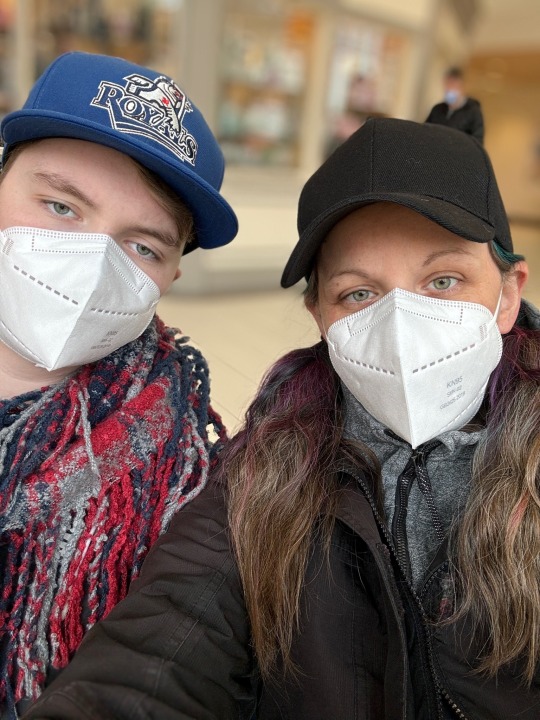
#metastatic breast cancer#health update#life update#mri#ct scan#lab work#cancer treatment#oncology#this is mbc#inspired#blogging on my blog#Spotify
11 notes
·
View notes
Text
Man, some folks need to read a book or two on the history of medicine.
Try Roy Porter, Carole Rawcliffe, or Steven Cherry. There are also great articles often available for free on Pubmed. If not, email the first author - they'll get it to you.
(Hey, did you know the debate about whether consciousness was stored in the heart or the brain continued until the 18th century? And that the father of neuroscience, Santiago Ramón y Cajal, lived until the 1930s? That an understanding of Mendelian genetic inheritance in humans - an "inborn error of metabolism" - was postulated based on a family in London with Alkaptonuria, aka "black urine disease," and that that research was not published until 1902 (by Archibald Garrod). Between 1902 and the present, basically everything we know about chromosomal-level genetic inheritance and mutation was discovered? Did you know that the reason calico and tortoiseshell cats are always female is due to the presence of Barr bodies, which is an inactive X chromosome, and this can also be seen in humans, including in males with Klinefelter Syndrome [XXY] and in sterile male calico/tortoiseshell cats? And that even more rarely, a male calico/tortie is not sterile?)
(Do you know why the Hippocratic Oath is called the Hippocratic Oath? Who Galen is? The age of the oldest known eyeglasses? The four humors, and what they were believed to represent? Why medicine stagnated during the first few centuries of Christian dominance in Europe? What the link is between sickle cell anemia and resistance to malaria? What is the modern treatment for bubonic plague? Who Phineas Gage was? What animal Luigi Galvani used to study the role of electricity in neural connections? Who frickin' Rosalind Franklin is???)
Seeing that post about arguing against there not being enough research into hormonal and surgical treatments for trans men and women... Man. That one hurt my head.
Since 1990, we've learned how to keep HIV all but dormant and to stop it passing from a parent to child. Chemotherapy for cancer treatment was first developed in the 1940s, and radiation is actually older than chemotherapy. Hemophilia B can be treated now quite simply by injections and transfusions to introduce Factor IX, a clotting factor, when before the 1950s it was a death sentence. The structure of DNA wasn't discovered until 1953 - now, students in basic biology labs can play around with splicing and inserting sequences into genetic codes!
My point is... a lot of what we understand about medicine has, for various reasons, only become established and accepted in the last 200 years or so. And with gene therapy, it's likely to explode again.
Read up on the history of medicine. Especially if you question its use in certain people to help them physically become who their conscious mind knows they are. You might learn something!
And honestly, the history of medicine is insanely grim-and-gross fun. If you're into that. 😉 The Mütter Museum is also out there!
69 notes
·
View notes
Text
PATHOLOGY OF THE URINARY SYSTEM (aka: STUFF WHAT GOES WRONG WITH YER PISS BEANS)
(AND YER PISS TUBES)
(and the pretty pictures I take of them)
[a warning: this post contains radiographic images and non-graphic description of serious kidney pathologies, including paediatric cancer]
Let's kick off with an old familiar friend! Yeah, I'm talking -
UROLITHIASIS (the humble kidney stone!)
Wanna know something horrific? The biggest kidney stone on record weighed over a kilogram. It was 17 cm across. Just. Imagine. Trying to piss that out…
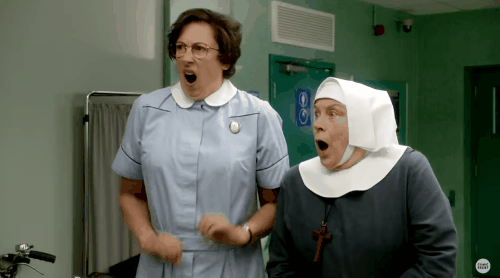
Urolithiases are formed anywhere among your urinary tracts. They’re commonly found in the kidneys, giving rise to the more common term, renal calculi, or kidney stones.
Urolithiasis occurs when compounds within your urine crystallise. If your urine becomes too acidic, too base, contains too many of these compounds for them to remain in solution, or simply… sits around too long without flowing, it literally petrifies into a solid lump!
Some unlucky souls are just… predisposed to developing them. If you have had a kidney stone in the past, you are far more likely to get another one in the future. There also seems to be a genetic link – so if someone in your immediate family gets kidney stones, you have a higher risk.
Kidney stones typically hang out in the pelvis of your kidney and don’t cause an issue. Until you try to piss them out. Remember our kidney diagram (drawn on a conveniently shaped bean)?
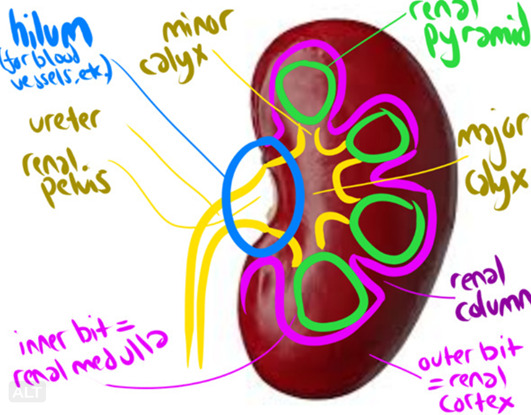
You might notice that the ureters are significantly smaller than the renal pelvis. In other words…

Most renal calculi are made of CALCIUM (oxalate, usually). This is very, very good (for us. Less so for you) because calcium attenuates x-rays – meaning, it glows all pretty and shiny when we take a radiograph!
Here’s a kidney stone on an Abdominal X-Ray!
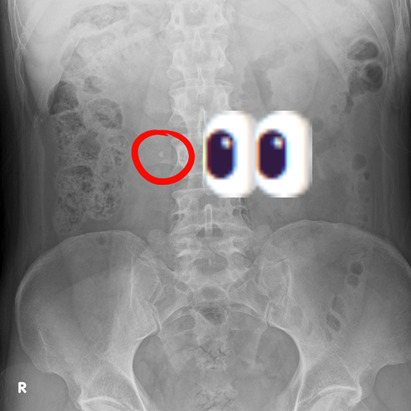
And a twinkly artefact caused by a kidney stone on Ultrasound!
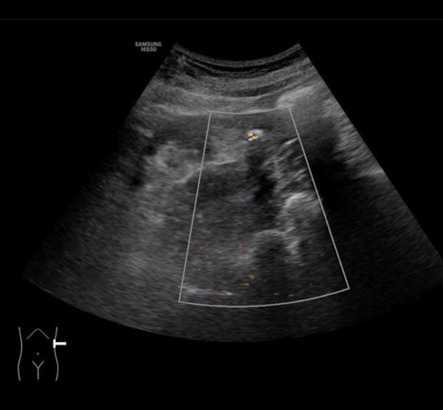
But the best way to assess urolithiases, is, of course, with CT!

For realsies. We don’t need to inject contrast intravenously, because the kidney stones are (typically) shiny – which cuts down on time and worry, as it means you’re at no risk for having an adverse reaction! So a CT KUB (checking Kidneys, Ureters and Bladder for stones) is basically just a quick tumble in the washing machine (CT scanner), with a lovely clear picture as a result!
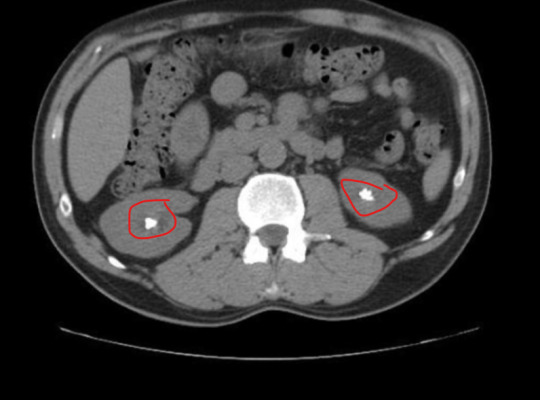
Look at these babies!! So sharp!!! So clear!!!!!! So shiny!!!!!!!!!!!! That’s a beautiful matching pair of renal calculi right there – and to make things better, they’re (currently) non-obstructive, so this patient isn’t in suffering The Agonies!
Speaking of The Agonies…
Most kidney stones are passable, albeit with extreme pain.
However, some ain’t going anywhere. Especially staghorn calculi, which, um. One, stags have antlers. Two…

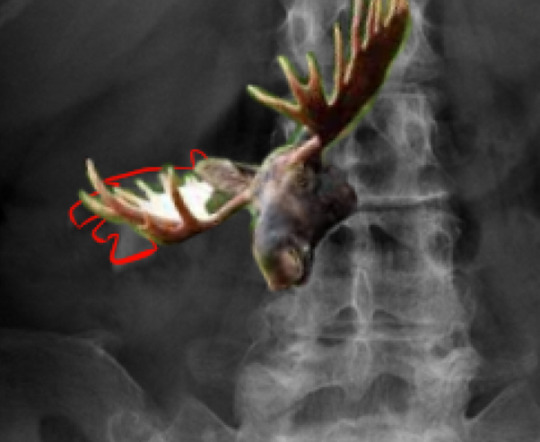
more like a fuckin' MOOSE ANTLER amirite????
But yeah, those buggers aren’t coming out. That’s almost definitely going to require surgery!
Smaller calculi can still cause problems when they become obstructive – i.e., they block the passage of your peepee. They can lead to:
HYDRONEPHROSIS (dilation of the renal pelvis due to retained urine, seen here in the Left kidney [right side of image])
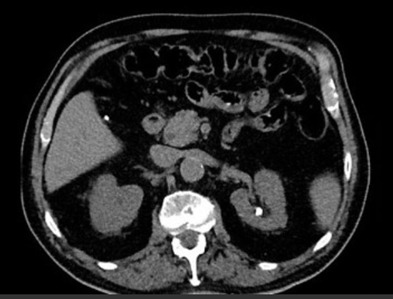
HYDROURETER (dilation of the ureter)
So, what do we do with bothersome calculi? How about some...
EXTRACORPOREAL SHOCKWAVE LITHOTRIPSY (ECSWL, because we love a sexy little acronym here in medworld).
We blast the stone apart with shockwaves, from outside your body! Ultrasound turned up to 11! Unfortunately, it only works on certain densities of stone, and on small stones.
LASER LITHOTRIPSY
(same thing but…. ZIP ZAP LASERZZZZZ]
SURGERY – PERCUTANEOUS NEPHROLITHOTOMY (PCNL).
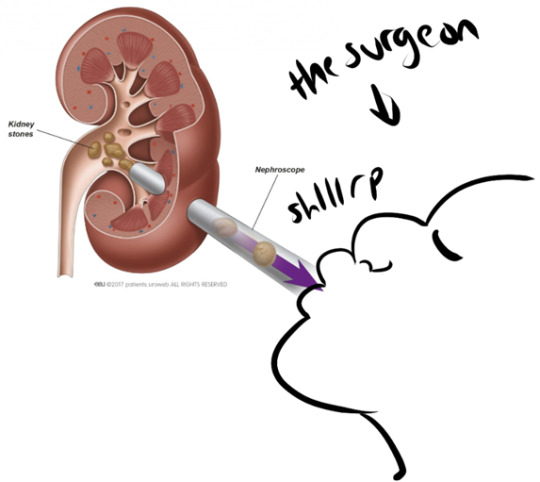
(I totally haven’t added to this diagram in any way. This is how it works. Trust me.)
LOADS of other stuff can go wrong with The Ol’ Piss Beans
We have:
RENAL CELL CARCINOMA
The most common form of kidney cancer.

For suspected malignancies, we do a CT Urogram that assesses the whole urinary tract. This takes significantly longer than a KUB, but is well worth the results. This is a three-phase scan. We do...
A regular KUB non-contrast scan to check for calculi and to get our baseline Hounsfield Units ('grayness' and densities) for the kidneys.
Then we inject contrast in a 'split bolus' - one load immediately, and another roughly 8 minutes in, scanning roughly a minute after the second injection is given.
We scan 80 secs after the first contrast bolus is administrered, for the 'nephographic' phase, which enhances the renal cortex & medulla, and makes neoplastic changes and renal masses obvious (see image above).
Then we wait 10-ish minutes and scan for the 'excretory' phase, after the contrast has worked its way through your kidneys, to detect 'filling defects' (anything that stops contrast opacification of the ureters) and pathologies related to the urinary collection system.
NEPHROBLASTOMA
This is one of the more common cancers found in kids. Although paediatric cancer is never exactly a happy topic, this cancer is now curable in roughly 90% of cases, thanks to the early removal of kidneys and the possibility of transplants.

Autosomal Dominant (and Recessive) Polycystic Kidney Disease
An inherited renal disease that can cause you to go into End Stage Renal Failure due to the healthy tissue in your kidneys becoming completely overtaken by cysts. As a result, your kidneys can grow more and more, until they practically fill your whole abdomen. 45% of patients will be in ESRF and need dialysis by the age of 60. Thankfully, transplants are an option.
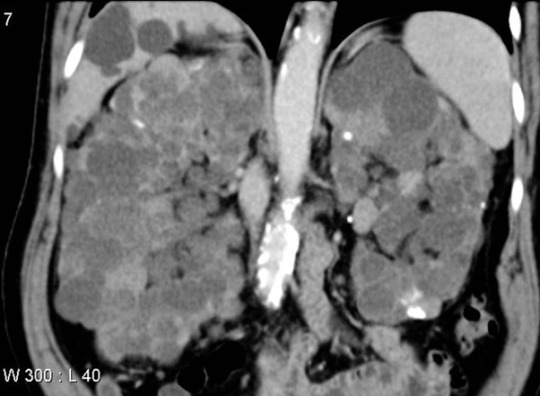
Other commonly encounutered renal pathologies include trauma, which I talked about in my first kidney ramble (linked here!), infections, and more.
I hope you enjoyed this whistle-stop tour of Stuff That Can Go Wrong With The Kidney, And How We Look At Them Gnarly Beans!
....And, um, I spent way too long making this and now need to pee. This is your reminder to go empty that bladder if you need to! Stop those stones!
12 notes
·
View notes
Text
The Vital Art
When the human species began to master the molecular machinery that underlay its own existence, the first applications were thoroughly practical. It eventually became simple to engineer viruses that, injected into one's bloodstream, would go hunting on their own for pathogens and cancerous cells, and destroy them instance by instance with a thoroughness and ruthlessness that would make an inquisitor shudder. It was not unheard, of course, that some of these viruses would escape control and become pathogens of their own, as any selfish mutant would necessarily enjoy an immense evolutionary advantage over its obedient brethren. But other waves of nano-cleaners would come to chastise the first, and it would be rare for more than one to rebel.
Bacteria and other such microbes would be tailor-made for all sorts of industrial applications. The cunning alchemies devised by four billion years of seething mutation and merciless selection could be gathered and placed together by the foresight of intelligence. Some would be sprayed over landfills and polluted rivers to break down plastic polymers, encase radioactive waste in glassy foam, strip polluting organochlorides of their flesh-warping powers. Others would swarm on metal structures and use the energy of sunlight to reverse the oxidation slowly eroding their beams; or sifted through mining waste to concentrate and purify metals. It was possible to translate any message into a sequence of nucleotides, and to store them safely in bacterial spores, packing terabytes of data in a droplet of water. All had been carefully crafted so that they could never survive within animal bodies.
Thence it was hardly a leap to cultivate animal and vegetal cells in aquaria and petri dishes. It became trivial to grow any tissue from a single cell; and soon later, authentic giant panda meat was no more expensive than chicken breast. The basest mixture of organic matter, down to dead leaves raked from a yard, could be liquefied into nutrient broth, and sown with the seeds of a feast worthy of royal courts. Rumors were heard of wealthy eccentrics dining on their own projected and multiplied flesh. (Conveniently enough, large swathes of humanity agreed that raising animals for meat was a moral outrage only a few years after synthetic meat had become cheap and satisfactory; though not large enough to prevent meat breeds from surviving as pampered status symbols in isolated regions of the planet.)
Bio-artists managed to grow whole functional organs out of stem cells; and then linked them with artificial nerves and guts and blood vessels, giving life to minimal creatures, networks of interconnected glands lying in a collection of petri dishes. These could turn food into colored secretions or pleasant scents, baring every step of the process to the gawkers. Miniaturized versions were later enclosed in a smooth carapace and sold as decorations, such as living lanterns that could produce a warm firefly light for a few drops of nutritive solution. Designing self-sustaining systems that could perform such functions on a spoonful of sugar became a common assignment for schoolchildren.
Some bioart companies released all-purpose "basic creatures" into which decorative organs could be plugged and exchanged at will, so that the same pulsing fleshsac could nourish a cluster of multi-colored lights one day, musk glands with the scent of lavander and pine resin the next, then a chitinous carillon or a battery-recharging orifice. Subcultures made a game out of the collection of functional organs. This resulted, for a while, in unpleasant exchanges of pathogens; and many owners found expensive organs swollen and oozing with infections. Specialized antibiotic vials became very quickly an indispensable accessory.
All the arts of the animal and vegetal kingdoms were repurposed for human enjoyment. Cephalopod skins were grafted onto the manufactured creatures, and stimulated electrically so that pigmented cells would expand or contract as commanded, serving as biological pixels to display pictures and videos. Swarms of fabricated insects danced in the sky in evanescent shrouds, painting streaks of light with the glow of their own bodies. Worm-like ribbons were wrapped around Christmas trees, or around columns and lampposts during public holidays, to fill the air with the colors of their photophores, or festive stridulations; artificial syringes and gular sacs modeled after tree frogs and siamangs to produce songs of staggering beauty and complexity, with an organic, animal quality that no mechanical instrument nor human voice could have produced.
Synthetic pets came into demand, offering more flattery of human biophilic instincts in lieu of the cleanliness and efficiency of pet robots. They were built at first in imitation of slugs and shrimps (without unpleasant secretions, and built to withstand the manipulation of impatient children), then of birds and mammals. Soft textures, pleasant sounds and smells, endearing features were agreed upon in bioaesthetic committees, endlessly simulated in virtual ontogenesis, and finally translated into proprietary genetic code and packed into a convenient egg. Clean and sexless they were made for families that would feed them daily with patented formulas; and others were made in less innocent places for less innocent purposes.
Brain-designing teams became accustomed to threading a very fine needle, creating minds that were developed enough to avoid most frustrations of pet-owning, without crossing the threshold that would grant them the same personhood and self-ownership granted in extremis to the last gorillas and elephants. Years of poring over the daedalus of neurons with the resources of industry and its hunger for results uncovered many secrets that would feed the next waves of the vital arts.
The following wonder was of course the return of recently extinct species, the delicate-hued passenger pigeon, the reptile-jawed Tasmanian wolf, the purple-cheeked orangutan. Century-old plans were fulfilled as ruddy herds of mammoths wandered once again the pale tundra, although they had to be relocated to a thawing Antarctica. Much clamor was raised by the announce of restored dinosaurs, which were later revealed to have been manufactured out of modified emus and hoazins. Still they enjoyed a great popularity, in increasingly bizarre forms, that eventually resembled more the drooling monsters of ancient movies than the breathing animals of the Mesozoic. They were joined by other false resurrections, the living effigies of clankering sea scorpions, wheezing proto-tetrapods, and gibbering australopithecines.
The orangutans enjoyed the greatest success of all resurrected creatures; they established a thriving population in the half-sunken ruins of a once-great megalopolis in Southeast Asia, whose surviving inhabitants had long since moved to floating swarms of pelagopoleis. For many decades the reborn apes could be sighted from the sea, sitting placidly under red shawls of fur, on the greening roofs and rusting pylons. Apparently jealous of their own new life, they disappeared quickly into the thickest brush, or into galleries believed to extend deep below the sea level of that time. Many fantastic conjectures were made about their secret existence, though nobody quite managed to probe it by force or deceit. Presumably, when the War came some three decades later, the resurrected orangutans fell for the second time into the chasm of extinction.
In the later phase, mammalian and even human brains were produced, some apparently capable of nervous activity. There were many ways to expose it to the world: in some cases it was translated into a musical codex; in others, the outer cortex was made translucent, and the flow of neurotransmitters could be seen as a warm-colored glow. A Museum of Qualia was briefly opened in a northern city, where one could experience the colors of distant longing, the textures of sexual rapture, the notes of filial love, and the taste of divine inspiration. It became simple, then, to induce the same sensations in natural brains, and make everyone into a poète maudit and a prophet of God.
Most synthetic brains were mercifully awash in endorphins for all their existence. But in one infamous case, a particularly mad artist had their farmed brain glow with neuronal activity in ways consistent with excruciating pain. The debates were fierce, on questions both of fact and moral, and after a few months the damned creature, if such it was, was disconnected from support and incinerated. Its luckier brethren followed it soon. The natural-born brains that had been stored and preserved in view of a future reanimation, which for the time trauma or decay had made impossible, were kept in storage as long as dutiful heirs or charitable organizations funded it, and not one minute longer.
This one scandal marked the zenith of popularity of the vital art, and from there it swiftly withdrew from public exaltation into the pockets of practicality -- food production, medicine, waste treatment -- where it could not be abandoned, and where people had long accepted it as normal and natural. People would still dine on vat-grown meat -- who but a savage would prefer another kind? -- and saved their loved ones from death with any necessary mean. But year after year, the breathing infrastructures were quietly dismantled or fell into disrepair, and the synthetic companions lost much of their appeal.
Many countries of the world banned the applications of the art that were not essential, and some of those that were. Quickly the wealth of volumes written on the manipulation of life became little more than a catalogue of past curiosities, a glimpse into the alien thoughts and values that so recently were the rule.
In the last few years before the War, new developments of the vital art only occurred in secret, in the laboratories of tyrants and revolutionaries, meant not for unscrupulous creation, but for exceedingly scrupulous destruction.
9 notes
·
View notes
Text
"Five people have gone into remission thanks to advancements in medicine — and a sixth patient may also now be free of HIV.
One of the biggest breakthroughs in HIV/AIDS prevention in recent years is the widespread use of PrEP (pre-exposure prophylaxis).
This drug therapy, approved by the Federal Drug Administration in 2012, has been a key player in preventing HIV transmission through sex or injection drug use. Antiretroviral drugs, such as PrEP, also slow the replication of the virus and prevent it from progressing to AIDS.
Although PrEP has become a more accessible treatment for the virus, scientists have been hurriedly working towards cures for HIV for decades — and we’re finally seeing some results.
In February of this year, scientists in Germany confirmed a fifth-ever patient had been cured of HIV after receiving stem cell transplants that include genetic mutations that carry a resistance to HIV.
But it looks like a sixth patient may soon be able to join this very exclusive club.
The man, referred to as the “Geneva patient,” underwent a stem cell transplant after cancer treatment, though these cells did not include the HIV-resistant genetic mutation.
Still, he went off antiretroviral therapy for HIV in November 2021, and his viral load remains undetectable.
Instead, doctors are researching whether a drug called ruxolitinib may be partially responsible for his recovery.
Ruxolitinib decreases inflammation associated with HIV by blocking two proteins, JAK1 and JAK2. This helps kill off “reservoir cells” that lay dormant in the body and have a potential to cause rebounds in patients with HIV.
Experts say the AIDS crisis can end by 2030 across the globe — as long as leaders prioritize this goal.
A new report from UNAIDS shows a clear, optimistic path to ending the AIDS crisis. (This looks like a 90% reduction in cases by 2030.)
The organization’s report includes data and case studies that show that ending AIDS is a political and financial choice — and that governments that have prioritized a path towards progress are seeing extraordinary results.
By following the data, science, and evidence; tackling inequality; and ensuring sufficient and sustainable funding across communities, the global community could wipe out the AIDS pandemic by the end of the decade.
The report demonstrates that progress has been strongest in the countries and regions that have the most financial investments, like eastern and southern Africa, where new HIV infections have been reduced by 57% since 2010.
Investments in treatments, education, and access to care have also led to a 58% reduction in new HIV infections among children from 2010 to 2022 — the lowest number since the 1980’s.
Plus, the number of people on antiretroviral treatment around the globe has risen from 7.7 million in 2010 to 29.8 million in 2022.
The moral of the story? This goal can be achieved, if world leaders put their minds — and wallets — to it.
A region in Australia might be the first place in the world to reach the United Nations targets for ending HIV transmission.
Researchers believe that the central district of Sydney, Australia is close to becoming the first locality in the world to reach the UN’s target for ending transmission of HIV.
Specifically, new infections among gay men have fallen by 88% between 2010 and 2022. In fact, there were only 11 new HIV cases recorded in central Sydney last year, and almost all HIV-positive Australians are on antiretroviral drugs.
... "These numbers show us that virtual elimination of HIV transmissions is possible. Now, we need to look closely at what has worked in Sydney, and adapt it for other cities and regions across Australia.”
Namibia is ahead of schedule in UN targets to end HIV/AIDS.
Although the virus is still the leading cause of death in Namibia, the country is well on track to hit 95-95-95 UNAIDS targets before its 2030 deadline.
In Namibia, 92% of people know their HIV status, 99% of people living with HIV are on treatment, and 94% of people living with HIV who are on treatment are virally suppressed.
In addition to these exciting statistics, new infections have plummeted. The estimated rate of new HIV infections in Namibia is five times lower than it was in 2002, according to the Centers for Disease Control & Prevention.
These encouraging numbers are thanks to the investment and strategic response of PEPFAR, but also to the willingness of local governmental agencies and organizations to adhere to the UN’s Fast-Track approach.
Breakthroughs are being made in HIV vaccine therapies.
Long before we were all asking each other “Pfizer or Moderna?” about our COVID-19 vaccines, scientists have been researching the potential of mRNA vaccines in treating some of the world’s deadliest diseases — like HIV.
And with the success of our mainstream mRNA vaccines, an HIV inoculation remains a goal for researchers across the globe.
Last year, the National Institutes of Health launched a clinical trial of three mRNA vaccines for HIV, and similar studies are being conducted in Rwanda and South Africa, as well.
CAR T-cell clinical trials are underway to potentially cure HIV.
This spring, UC Davis Health researchers have dosed the second participant in their clinical trial, which poses the use of CAR T-cell therapy as a potential cure for HIV.
The study involves taking a participant’s own white blood cells (called T-cells), and modifying them so they can identify and target HIV cells, ultimately controlling the virus without medication.
The first participant in the study was dosed with anti-HIV T-cells last August, and the trial is the first of its kind to utilize this technology to potentially treat HIV.
Of course, the trials have a long way to go, and the lab is still preparing to dose a third participant for the study, but CAR T-cell treatments have been successful for lupus and forms of cancer in the past...
“So far, there have been no adverse events observed that were related to the treatment, and the two participants are doing fine.”
Guidance on how to reduce stigma and discrimination due to HIV/AIDS is reaching people around the globe.
While the stigma surrounding HIV and AIDS has significantly decreased — especially towards the LGBTQ+ community — with advancements in treatment and prevention, discrimination is certainly not gone.
While most people now understand HIV/AIDS better than they did decades ago, those most impacted by the virus (like gay men and low-income women and children) still face ongoing barriers to care and economic security.
It is vital to maintain awareness and education interventions.
After all, experts suggest that eliminating discrimination and stigma are key factors in reducing disease. And not eliminating stigma impedes HIV services, argues UNAIDS, “limiting access to and acceptance of prevention services, engagement in care, and adherence to antiretroviral therapy.”
Luckily, UNAIDS provides guidance on how to reduce stigma and discrimination in the community, workplace, education, health care, justice, and emergency settings.
The goal is to, of course, decrease stigma in order to decrease disease, but also to provide folks with the culturally significant support they need to live safe, integrated lives — with or without disease.
For instance, a 2022 study conducted in Northern Uganda showed that local cultural knowledge passed through Elders was a successful intervention in reducing HIV-related stigma among young people.
“Research in school settings has shown that the use of local cultural stories, songs, myths, riddles, and proverbs increases resilient coping responses among students and strengthens positive and socially accepted morals and values,” the study’s discussion reads.
So, while an uptick in acceptance gives us hope, it also gives us a directive: Keep telling the accurate, full, and human stories behind HIV/AIDS, and we’ll all be better for it. "
-via GoodGoodGood, August 3, 2023
#hiv#hiv/aids#aids crisis#public health#medical research#vaccines#australia#namibia#united nations#queer issues#trans issues#lgbtq issues#lgbtq community#infection prevention#good news#hope
270 notes
·
View notes
Text
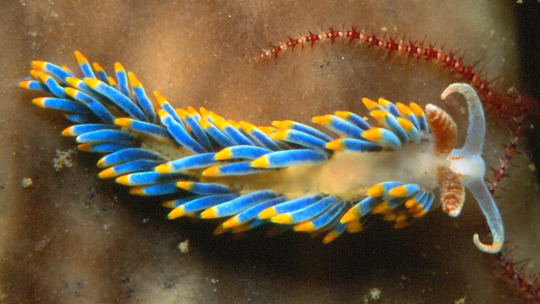
Nudibranchs- one of the most beautiful order of molluscs
Nudibranchs are an order of marine gastropod molluscs that are often found inhabiting coral reefs, deep sea waters, rocky sea shores and seagrass beds world wide. While they may look like fuzzy, bright gummy worms, they are real creatures.
Appearance
Nudibranchs vary in shape, size and colour, though they are very distinctive and easy to identify because of their unique appearance. Nudibranchs come in a variety of bright and often vivid colours, ranging from vibrant oranges, yellows, blues, and purples to more subdued tones. Their colour serves as a warning to predators, indicating that they are toxic and unpleasant to eat. They have soft, flexible bodies and distinctive shapes, varying from long and streamlined to bulbous and flat, depending on their species. Many nudibranch species have ornate appendages on their bodies, including cerata (finger-like projections), rhinophores (sensory organs resembling horns or antennae), and sometimes even feathery structures.
Defense, Diet and Predators
Nudibranchs have mouths that have radulas in their mouths, an organ that helps them eat. They're carnivorous, often eating sea sponges and cndarians. They steal their stinging cells (nematocysts) from their food they eat, making them toxic to predators who don't spot their bright warning colours before deciding to eat them. When attacked, toxic nudibranchs will discharge their toxins to discourage their predators from continuing.
Breeding
They're hermaphroditic, meaning they can mate with any mature gender of their kind. During mating, mates will inject sperm into each other via penis. Some species of nudibranchs will crawl out of eggs as juveniles while others come out as larvae.
Other facts
-Nudibranchs get their name from the Latin 'nudus' (naked) and Ancient Greek 'brankia' (gills), due to their exposed breathing apparatus
-Scientists are using nudibranchs for medical studies
-They're coloured that way because of the food they eat
-Their size ranges from a few centimetres to 30 centimetres long. The largest British species has been recorded at 20cm long.
-Conservation status: common
🔗Links 🔗
How nudibranchs are being studied in medicine: Frontiers | A Nudibranch Marine Extract Selectively Chemosensitizes Colorectal Cancer Cells by Inducing ROS-Mediated Endoplasmic Reticulum Stress (frontiersin.org)
Nudibranch experts and enthusiasts: nudibranchdomain.org
#marine biology#marine animals#facts#incredible#nudibranch#sea bunny#sea slug#deep sea#marine life#gastropods#molluscs#beautiful#wildlife
3 notes
·
View notes
Text

My goodness, how has the last day of March come round so quickly? It is Easter Sunday too, the traditional day for giving Easter eggs, all those children running around “hyper” from too much chocolate!
I was hospitalised on Monday, had a catheter fitted in my femoral artery and had an early night as I was to wake up at 4am, washed breakfasted and be ready for the taxi to pick me up at 5am to take me to the hospital in Paris. Once again I was having cells collected, not stem cells this time but cells which will be engineered to fight the cancer cells in my body. Oh well will find out more as the procedure rolls along.
It was a grey day for the journey, which was a shame as the chauffeur drove me alongside the Seine, there were some gorgeous houses.
We went through the commune of Vincennes, where I spotted the Hippodrome de Vincennes (the Racecourse) recognised by the white railings as seen at Redcar, The Knavesmire etc. We then passed the Château de Vincennes, it was difficult to photograph through a rain spattered window. Then in the distance I saw the Barriere du trône we drove right past them too. I love these trips into Paris where the chauffeur always wants to highlight some of the lesser known sights.
When I arrived, on foot, at the hospital the nurse tutted! I should have been on a trolley (I knew this from before) but was pleased that my taxi company had sent a car. However, as he was unsure where I wanted to be, we parked up, walked to one place then had a longer walk to where I needed to be. She asked if I had had breakfast, said yes at 4am, so she brought me another breakfast which I thoroughly enjoyed.
My blood was collected, the nurse kept asking if I wanted the tv on, don’t know why as I slept almost all day. I was concerned about the chauffeur, how was he filling his day? How tired would he be for the journey back? I needn’t have worried, they cater for this at the hospital, he too had slept and was refreshed for the journey back. There were more sights to see on the way back through Paris, no good trying to get photos, but I did see “Eglise du Saint-Esprit de Paris” and the “Fontaines aux Lions” which is very impressive albeit being used as a roundabout. Our homeward journey was in torrential rain, you couldn’t see tail lights until you were almost on the vehicle! However he kept the speedo on 141 k/hr in the 130 zone and we made good progress 😂😂.
The chemo they had given at the end of February had done what was asked of it, so the Doctor in Paris said another session of chemo would be given. This was done over three days and I gave up pestering to be allowed home as I realise that by keeping me here any transfusions or injections that need to be given can be administered promptly and they are just safeguarding me. Although I had an injection to boost white blood cells yesterday, I was surprised when the doctor said this morning that it had risen from 2,000/? to 20,000 in one day. I told her I had had pain in my bones, shoulders, back etc and she said that was as a result of the white cells, not that I am a doctor, but it may have something to do with bone marrow. She said I should have asked for pain relief, I said it wasn’t that bad, I managed to sleep, but I know in future. The nurses are always checking with me for pain but I think I am on enough flipping meds so will only request it if it becomes too severe.
The catheter came out about three days after it was put in, certainly comes out easier than going in! I have had to have a test on my brain functions, it was ok, painless and listening to music at one point I was trying to think of the English words to a song and almost missed the commands to open and close my eyes. I have the date for an MRI scan and another PET scan, all of which are needed by Paris before the reintroduction of the cells.
I feel a little like Lyndsay Wagner in “The Bionic Woman” or maybe I will do when they put these engineered cells back into me!
I have had platelet and red cell transfusions this week and all I can say is “thank you” to the people who donate these.
Friday the food was abysmal, I hardly ate anything! Monique messaged, she would buy foodstuff and bring it to the hospital. I asked for cheese and ham baguette and a tuna salad sandwich, unfortunately she couldn’t get the tuna sandwich so brought three quiche, tuna and tomato, goats cheese and spinach and a leek one. I ate thé goats cheese one, ate half of the tuna and tomato and have the leek one to have at lunchtime if I fancy it. She also brought me a gorgeous cake, sponge with patisserie cream and fresh raspberries it was delicious! Plus, apples, pears, bananas, oranges and mandarins I certainly have plenty of fruit to keep me going!
The music choices this week start with Elton John, my personal favourite is “Sorry Seems To Be The Hardest Word” but as a family we loved to sing along to a track first released in 1979 then made Number 1 in 2003, it is “Are You Ready For Love”.
I really hope that I haven’t had this Fleetwood Mac track before as it was a toss up between “Big Love” and this track “Go Your Own Way”, which is from the “Rumours” album of 1977.
So the long Easter holiday break in the UK usually sees people spending their time sorting out the garden, doing DIY etc and for “The Trainee Solicitor” and “The Reconnect Navigator” they have really taken this on board. One of the hedges has been successfully trimmed back, there has been a massive clear out, floors washed and everywhere given a big spring clean. It could be the turn of the partially blocked drain today (weather permitting) I am also wondering if the hydrangeas from last year are putting out leafy buds? There was a friends birthday to celebrate yesterday, so hope there are no sore heads this morning.
“The Photographer” and “The Jetsetter” snapped a photo of one of my old homes. Memories flooded back and I was surprised I could remember so many names of school friends and other friends from the mid to late sixties. Some of these friends I even remembered their addresses! Just goes to show I don’t have a lot to tax my brain at the moment 😂😂.
The weather here is grey, damp and cold, it looks as if the North East of England has had blue skies and some sunshine even if it has been cool too. I have had messages from the US, one from my friend who has had treatment for breast cancer, she is thrilled that her PET scan is clear, I am thrilled for her too! Hopefully, she will return soon to her beautiful home in Bar-sur-Aube. The other friend had been to see Billy Joel in New York, his special guest was Gordon Sumner better known as Sting! This was a lovely surprise as my friend is from North East England so a “local lad” on stage was a bonus.
I am going to finish reading my second book today (only brought two with me) then no doubt I will just read social media and news on-line although that just seems to be full of doom and gloom. I can also listen to some music although don’t think I will be jigging about as I am getting plenty of exercise visiting the bathroom regularly!
So I wish you all a Happy Easter Day, don’t eat too many chocolate eggs, have a good day tomorrow too before the start of another four day week.
Until next week!
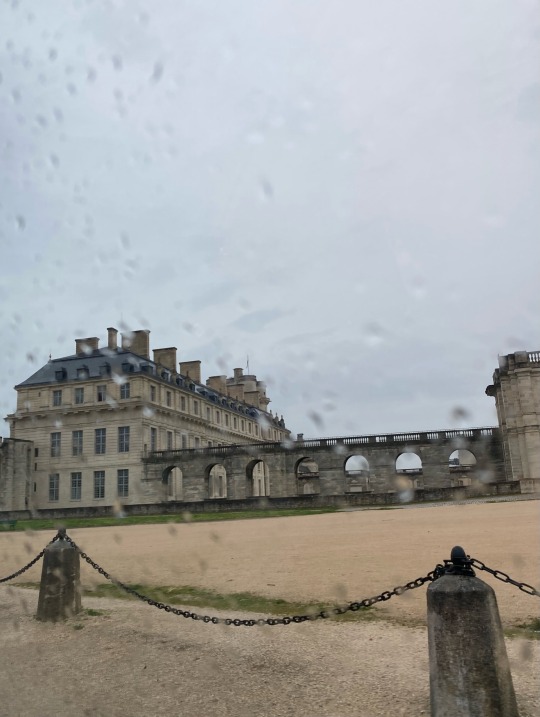
3 notes
·
View notes
Text
So, chemo.
Both the most overwhelming and boring thing I've done on this journey so far.
A lot of info, all at once. Haematologist assure me that we are going for cure, not just management, so that's good, but also warned me that because of the abnormalities in my type, we may need to change treatment quickly if things aren't working, which is... well, seems like a no-brainer to me.
Factor V is causing issues. They've taken me off warfarin for the duration of my chemo, and put me on high doses of Clexane injections, once daily for the moment but could go up to twice depending on what my platelets and blood count are doing.
They warned me that the first lot of chemo is always the longest, but instead of 6 hours, it ended up taking 8, so it was 10pm by the time I was out if there, and I was the last person to leave.
Huge handfuls of tablets to take. Steroids, anti-virals, antibiotics, anti-nausea, gout (to help clear out the dead cancer cells quickly), endone to sleep, panadol if I need it. Vitamin D and iron supplements.
So far, so good. I'm going to need a pill caddy to keep a track of all of the variations in tablets.
Day after chemo, and I'm ok. Tired, bruised from the forearm cannula and a bit flat, but nothing worse than the last few months. Metallic taste in the mouth is new, and will probably stick around. I had to laugh at the diet sheet they gave me; this is the first time in my life I've specifically been told not to lose weight.
I have to remember to take some handsewing with me next time, plus snacks and extra water. Even if chemo will be faster, it's going to be boring.
7 notes
·
View notes
Text
My boyfriend is in the hospital again.
I tried Whataburger for the first time today.
The doctor says, "The white blood cell count is,"
"A little elevated."
The burger was cold from the drive home, and my fries were limp.
His mother, a end of life nurse, says that she has seen terminal cancer patients with lower white blood cell counts.
I sweep my floor and talk to my dog to fill the silence.
The doctor says, "The tests we ran show nothing."
I hold my hand to his head and feel the fever pulsing through his skin.
The doctor says, "We'll give him some fluids and send him home."
I hold his hand while he struggles to not twitch away from the injection.
It snowed today, the first of the year, and maybe the last.
I sit by his bedside while his limbs convulse--in sleep he dreams of doctors.
Remember when it snowed, a year or so ago?
We were both off work, and we used old boxes and beach toys to sled
Down the hill, crashing into the fence, laughing with our fingers numb.
He begs me, not again, not another trip to the hospital.
I harden my heart and carry him to the car.
Remember when, a year or so ago, ypu decorated for Christmas the day after Halloween?
And I laughed and told you that if I weren't careful, you would have the tree up all year round?
I would let you keep the house in green and red and tinsel every day of the the rest of our lives
If you could come home to me tonight.
My bed is cold without you.
2 notes
·
View notes
Text
Pet death warning.
I was going to get some CC uploaded but I just. I just can’t. I’m sorry.
Jack is gone.
The long and short of it is he was exceedingly anemic and wasn’t producing any more red blood cells. He also had a fever of 105F they couldn’t explain even after blood work. Was showing signs of FIV. Also indications of bone marrow cancer. Treatment options were to be a hospital stay and transfusion but it would only prolong him for weeks/months, and seeing as he was only 5lbs and already unhappy, that seemed like a cruel thing to put him through.
He went peacefully in my arms. I got to say goodbye with him wrapped in his favorite blanket. He purred for a while before they came in to do the injection.
He was a very good boy and I’m going to miss him. He had a long and happy life--nearly 17 years. Ultimately he was where he wanted to be--with me, where he seemed to feel the safest and happiest--he was always the most happy when he was in my lap or in my arms and even sought me out right to the end.
I’ve asked for tomorrow off work. Please pray they give it to me. I feel like I have a piece of me that was torn out. It hurts so much, and even holding Fiona, his sister, hurts.
I’m glad I got to say goodbye to him and that he went at the end of a long and healthy life. But God it hurts.
I’m so tired. I’m going to miss him so much.
24 notes
·
View notes